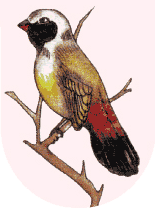When is comes to breeding Finches and Softbills, it is imperative in many cases to have a good source of livefood in order for the babies to be reared successfully. The traditional live food until recently has been Termites and Mealworms. Unfortunately due to development in the urban areas,termites have become difficult to obtain and mealworms can have undesirable side effects.
Here follows information on breeding Fly Maggots:-
Talk on Breeding Fly Maggots by Robbie Ihlenveldt
.Why maggots have been introduced to birds diet:
Live food is an imperative part of Finch and Softbill diets for breeding success
(i) Mealworms have a long (3month ) life cycle. Also contain a lot of fat leading
to fat birds. Fat/obese birds are poor breeders.
(ii) Flying ants are first prize but are difficult to obtain. Also contain a lot of fat.
(i) Termites: becoming more and more difficult to obtain due to new developments.Hence introduction of Fly Maggots. Maggots are easy to propagate, have a short lifespan and are clean without much smell. They also have a high content of
protein (approx28%) (see Pics)
PIctures of hatched Maggots and Fly Breeding Box

Robbie suggested that parrot breeders might like to try dry freezing maggots and adding to soft food to see if they will eat them Can only do good if they do.
Robbies Breeding cage is very large, (See Pic ) designed so as to provide temperate conditions. If heat near the lamp gets too hot flies can move away.
Sugar is the only food breeding flies require for energy needs.
They also need water, obtained using foam sponge soaked in water dish.
The required temperature is 26-34deg C
Methodology
Apart from sugar and water as mentioned, You`ll need 2 containers in which the breeding medium is placed.
A mixture of Milk Powder and Digestive Bran ( 5% --20% milk powder) is mixed together with water until just damp and placed in 2 containers and pressed down.
These are placed inside the fly cage. The female flies will lay eggs in this medium which will hatch out within 2 days into maggots.
The normal house fly will lay minimum of 300 eggs.
Take out and replace the containers of Breeding medium every 2 days.
Every 2nd day leave 1 container inside the cage for 8-10 days, so as new flies can hatch out and continue the breeding cycle. There will eventually be a regular routine of harvesting newly hatched maggots and replenishing with 1 tub for continued breeding purposes.
Robbies Breeding cage has a recessed section in which tubs of hatched maggots can be kept warm for further growth until ready to be fed to the birds. The maggots can also be kept in a fridge to stifle their growth.
